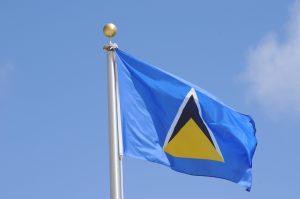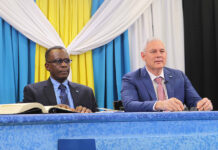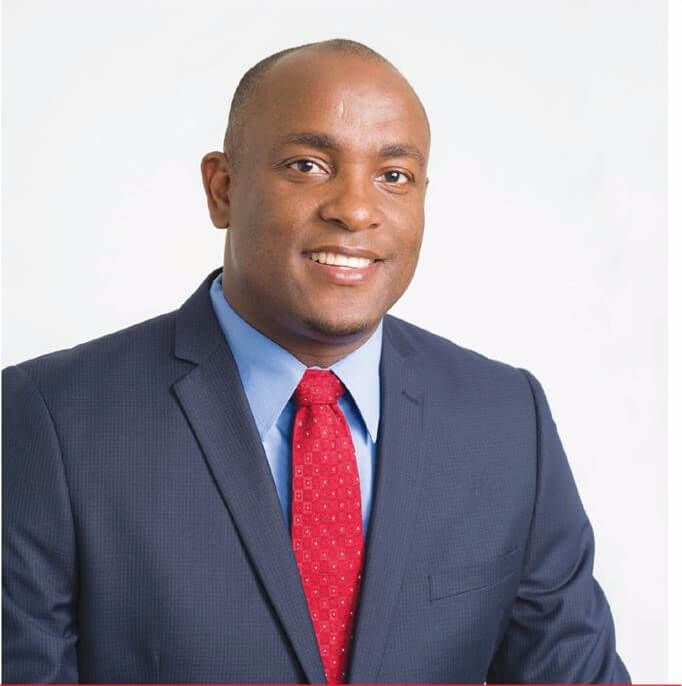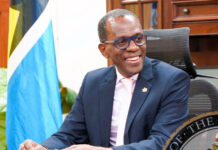
[dropcap]K[/dropcap]eynote Address Presented by Hilary La Force, Executive Director, Folk Research Centre on Wednesday March 1, 2017.
“To appreciate and understand the importance of our flag as a symbol of national identity, pride and unity, we need to step back for a moment into our history.
In August 1965, Chief Minister John Compton (whose new United Workers Party had won the general election in 1964) moved a motion in the Legislative Council – as it was known then – that the “Government of St. Lucia seek from Her Majesty’s Government in the UK, full internal self-government by 1st January 1966.”
After a three-hour debate in the Legislative Council, the motion was passed by a 9 to 2 margin. The two opposition members, Mr. George Charles, the former Chief Minister and Leader of the Opposition and Mr. Martin Jn Baptiste of the St. Lucia Labour Party, voted against the resolution. While they supported the view of the island achieving a new constitutional status, they felt that general elections should be held first. For those who are familiar with our political history, they will recognize that a similar situation was to arise again when the proposals for St. Lucia’s Independence were tabled in the late seventies.
After constitutional talks in London with other leaders of the Windward Islands (who were also seeking a new constitutional status) and which included representatives of both government and opposition, St. Lucia achieved Statehood in association with Britain on March 1st 1967, 50 years ago. St. Lucia would be responsible for all its internal affairs while Britain would oversee matters of external (foreign) affairs.
The Legislative Council became the House of Assembly; the Chief Minister became the Premier; the Administrator left St. Lucia and was replaced by our first native Governor, Sir Frederick Clarke. And St. Lucia, after the public was invited to submit entries, gained a National Anthem, with music by Leton Thomas and words by Fr. Charles Jesse; a coat of arms designed by Sidney Bagshaw, carrying the new national motto, “The Land, The People, The Light”; and its own flag, designed by St. Lucian artist, Dunstan St. Omer. It is worth noting that on December 13th, 1967, a few months later, the town of Castries was incorporated as a city, with its first Mayor, Mr. Joseph Desir. So in 2017, we are celebrating the 50th anniversary of our national symbols and our capital city. These are definitely worth a major celebration. This constitutional milestone with all the accompanying symbols was to prepare the way for Independence on February 22nd 1979.
In the Statehood Souvenir published by the Voice of St. Lucia on February 28th, 1967, there was an article entitled “Artist gives St. Lucia its national flag.” It reports that the flag had been designed by “39-year-old St. Lucia artist Dunstan St. Omer, winner of the National Flag competition.” The article goes on to say that his design of the new flag expressed “ the dominance of negro culture, associated with that of Europe, against a background of sunshine and ever blue sea, coupled with the island’s famous twin Pitons, rising sheer out of the sea, symbolistic of the new nation’s hopes.”
Indeed, the colours of the flag sought to capture the historical, social and geographical uniqueness of St. Lucia, called by the Europeans, the “Helen of the West” after the famous figure whose beauty and the problems it caused lay at the heart of the Trojan wars. There was the blue of the Caribbean Sea and Atlantic Oceans that surrounded us; the three triangles at the centre of the flag echoed the majestic Pitons, but also encapsulated the mixed racial history of her peoples, both African (black) and European (white). The gold triangle symbolized the tropical sunlight under which we live. While this was not mentioned, we wonder today if the three triangles also spoke to the Trinity of the Christian faith which dominated the island’s religious life.
So there, in its design and primary colours, the flag became a symbol of our national identity: who we were as a mixed-race people, predominantly black African, with remnants of our Amerindian heritage, a small East Indian population, and the strong ruling influence of centuries of domination by white European state and church. The flag spoke also to our latitude and longitude in the blue seas of the Americas, East and West, our geographical reality in the archipelago of the West Indies. And we were a golden tropical people, with all the verve and life and sunny dispositions of people of the sun. There, in all that, was our identity as a St. Lucian and Caribbean people.
The flag, in its bold, spare design, its tightness of form, its essential statement of cultural identity, spoke of a certain pride. After all, by 1967, our people had distinguished themselves in many areas, all around the world. While Arthur Lewis and Derek Walcott had not yet gained their Nobel prizes and their knighthoods, their works were well known around the world. We had doctors, historians, judges and singers (among other professions) who were household names in America, Europe, Africa, Asia and throughout the Caribbean. We were known as a hospitable and friendly people; our Creole culture with its unique Flower Festivals, La Konmet, chantwelles like Sesenne Descartes, its folk bands, were a source of pride. In fact, soon after 1967, there was to be a cultural renaissance that produced sound recordings of our folk music for the first time, that saw the drama productions of plays by Roderick Walcott featuring the music of Charles Cadet – all of which brought to the fore the rich cultural heritage of our St. Lucia. So there was justifiable pride in the citizens, in their heritage and achievements. The vertical, triangular strength of the flag spoke with a certain force to these things.
And the flag, bringing all this together in the strong, symbolic design of the master painter Dunstan St. Omer, stamped the sense of unity shared by St. Lucians at home and abroad. The history, culture, landscape, geographical placing at the centre of the Eastern Caribbean, captured in the colors and shape of the flag, asserted a unity that made St. Lucians, Saint Lucian!
St. Lucia today, 50 years later, no longer in associated relationship with Britain, but now fully independent since 1979, is a very different society. We are still found in the Eastern Caribbean at 13 degrees north, 60 degrees west. The seas, though carrying more pollution and the effects of climate change, are still blue. The sun is still overhead, though we now have effects of drought and water shortages. Our racial histories have been deepened with more arrivals from Asia, the Middle East, even the Far East, as well as continuing arrivals from Europe and America. The influence of North America is greater today than that of Europe. New generations have grown up, with new influences especially from entertainment, media and numerous technologies. Our creole culture no longer stands alone, but is found alongside many other cultural influences, both positive and negative. Drugs, crime, violence, political divisions, religious pluralities and other social realities, now have placed our pride and unity in great jeopardy. A frequent topic of debate today is the identity of St. Lucians. Who are we? Really? And there have been discussions about further developments to our political constitution to reflect, hopefully, a certain national maturity.
It may be that we do need a celebration of this Flag Day, which reminds us, in the symbolic message of the flag, what we once all hoped for, in terms of identity, development, pride based on real, positive achievements, and a continual working towards a real unity of nationhood. Who are we today? How does our flag represent us today? Are these foundational, symbolic values still meaningful?
So as we wave our flag, 50 years old today, perhaps we can think again, more deeply, about all these things.”











Comments are closed.